Social Listening: What It Is, Why It Matters and How To Start
Your guide to mastering social listening, from setup to strategy.
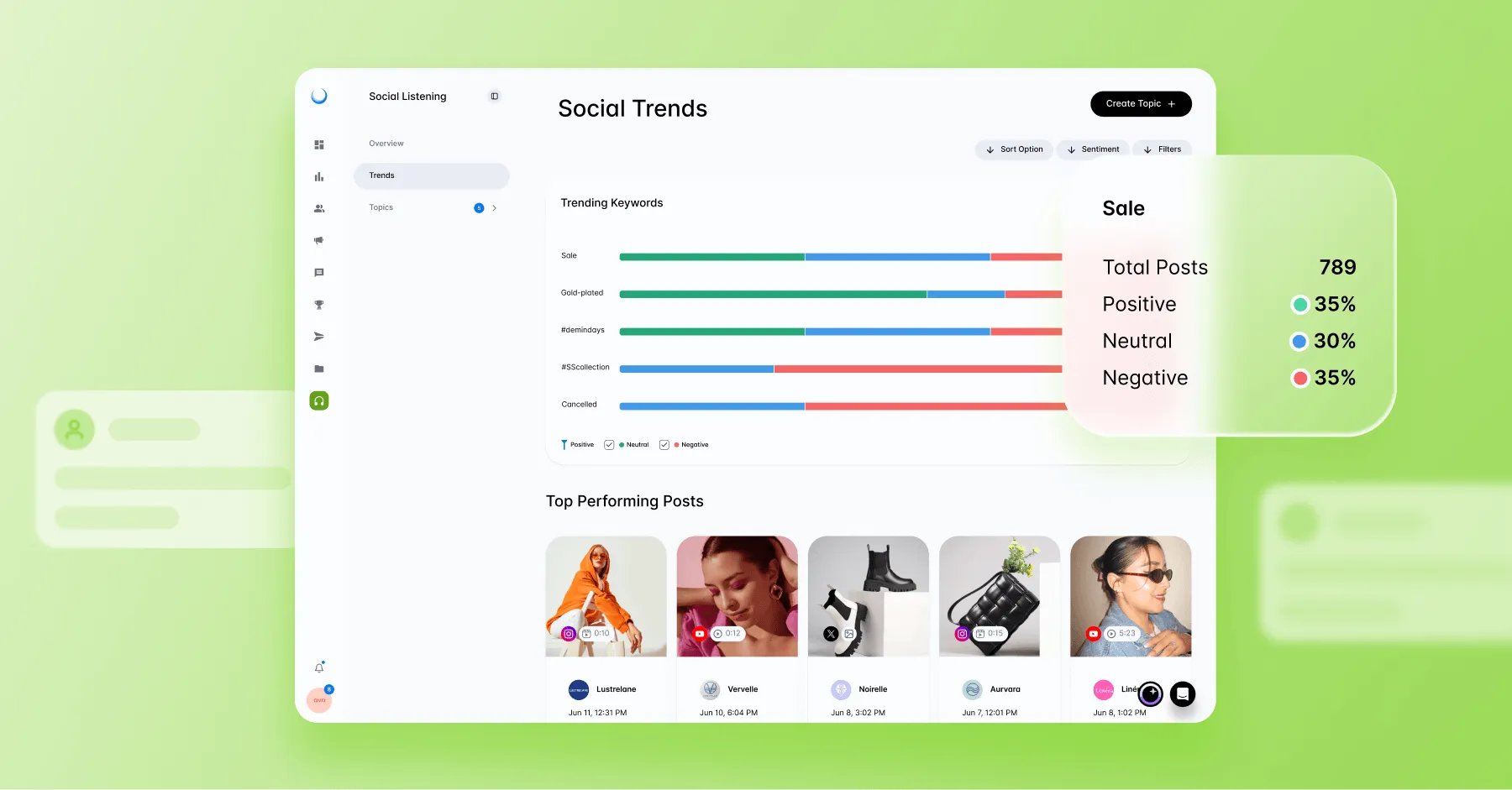
Social media is overflowing with unfiltered feedback, trending conversations and real-time sentiment, all of which can influence your brand’s success. Social listening is the key to unlocking this valuable stream of insight. Aside from eavesdropping, it helps shape strategy, spark innovation and build stronger customer relationships.
In a global 2025 survey of marketing professionals, nearly 76% reported using social listening software. If you’re not already leveraging these tools, there’s a good chance your competitors are, and they may be listening to what your audience is saying.
In this post, you’ll learn what social listening is, why it matters, the main benefits it offers, the top tools to consider and how to put it into action for your brand.
TL;DR:
- Social listening tracks and analyzes online conversations to uncover sentiment, trends and opportunities that shape brand strategy
- It differs from social monitoring by focusing on long-term insights instead of real-time engagement
- Benefits include deeper audience understanding, real-time brand health tracking, competitive intelligence and data-driven content or product development
- Leading tools like Dash Social, Sprout Social and Brand24 help brands collect insights and act quickly across channels
- Acting on insights strategically can strengthen community, refine messaging and keep brands ahead of cultural and industry shifts
What Is Social Listening?
Social listening is the process of tracking and analyzing online conversations to understand how people feel about your brand, industry, competitors and valuable topics. It involves monitoring mentions, keywords, hashtags and sentiment across social media platforms, forums, blogs and other digital spaces.
Why does this matter? Social listening gives brands a window into real-time consumer opinions and feedback, helping them uncover social media trends, address concerns and spot opportunities as they pop up. Instead of guessing what your audience wants, social listening lets you hear it directly from them.
So, how does social listening work? It starts with software that scans digital channels for relevant mentions and discussions. These tools then analyze the data, sorting by sentiment, volume, topic or source, so you can extract meaningful insights and act on them. Ultimately, social listening helps you refine messaging, shape new products and respond to customer feedback, turning raw conversations into strategic gold.
Social Listening vs. Social Media Monitoring
While they may sound similar, social listening and social monitoring serve different but complementary purposes in your social media strategy.
Think of social monitoring as the front line: it focuses on tracking mentions, comments, tags and messages in real time. It’s reactive, helping brands respond to customer questions, engage with followers or address complaints quickly.
Social listening, on the other hand, takes a step back to look at the bigger picture. It analyzes broader conversations, sentiment and trends over time. Social listening can turn online chatter into strategic insights that can shape content, campaigns and even product development.
Here’s a quick breakdown to easily compare aspects of social listening vs. social media monitoring:
As you can see, both are valuable. Monitoring tools help you react in the moment, while listening helps you adapt for the future.
4 Benefits of Social Media Listening
Social media listening isn’t just about hearing what’s being said; it’s about translating those conversations into meaningful actions. Here are four key benefits of integrating social listening into your social media marketing strategy:
1. Deeper Audience Understanding
Social media listening gives brands a direct line to customer sentiment. What people love, what frustrates them and what they expect next. By analyzing tone, emotion and recurring themes, you can build a richer understanding of your audience’s needs and preferences. This helps shape messaging that resonates and campaigns that convert.
2. Real-Time Insight Into Brand Health
From unexpected praise to brewing backlash, listening allows you to monitor your brand’s perception in real time. By spotting shifts in sentiment as they happen, you can address issues or amplify wins before they significantly impact your brand reputation. To stay prepared, it’s smart to develop a social media response plan in advance so you're ready to act quickly when it matters most.
3. Competitive Advantage
Social listening isn’t just about your brand; it’s also a powerful way to keep tabs on your competitors and broader industry trends. By monitoring competitor launches, customer frustrations and evolving expectations, you gain the insights needed to stay one step ahead. Curious how this translates into a strategic advantage? Explore our competitive benchmarking post to see how social listening fuels more intelligent market positioning.
4. Smarter Content and Product Development
Your audience is already telling you what they want; listening just helps you hear it. By capturing feedback and identifying trends, you can refine your content marketing strategy and even influence product improvements or innovation. It’s a direct way to make sure you’re building what your customers actually need.
Social Listening Platforms and Tools
Looking for the right tool to help you tune in to the conversations that matter? Below is a quick overview of some top social listening platforms to help you get started. For a more in-depth comparison, check out our list of the 20 best social listening tools.
Dash Social
Dash Social’s social listening solution combines real-time listening with performance tracking across owned, creator and paid channels. With brand-specific AI and built-in insights, it empowers marketers to act quickly, optimize content and stay ahead of the conversation.
- Pricing: Starts at $1,499/month with unlimited users
- Best for Industry: E-commerce, consumer brands
- Use Case: Unified social listening + campaign optimization
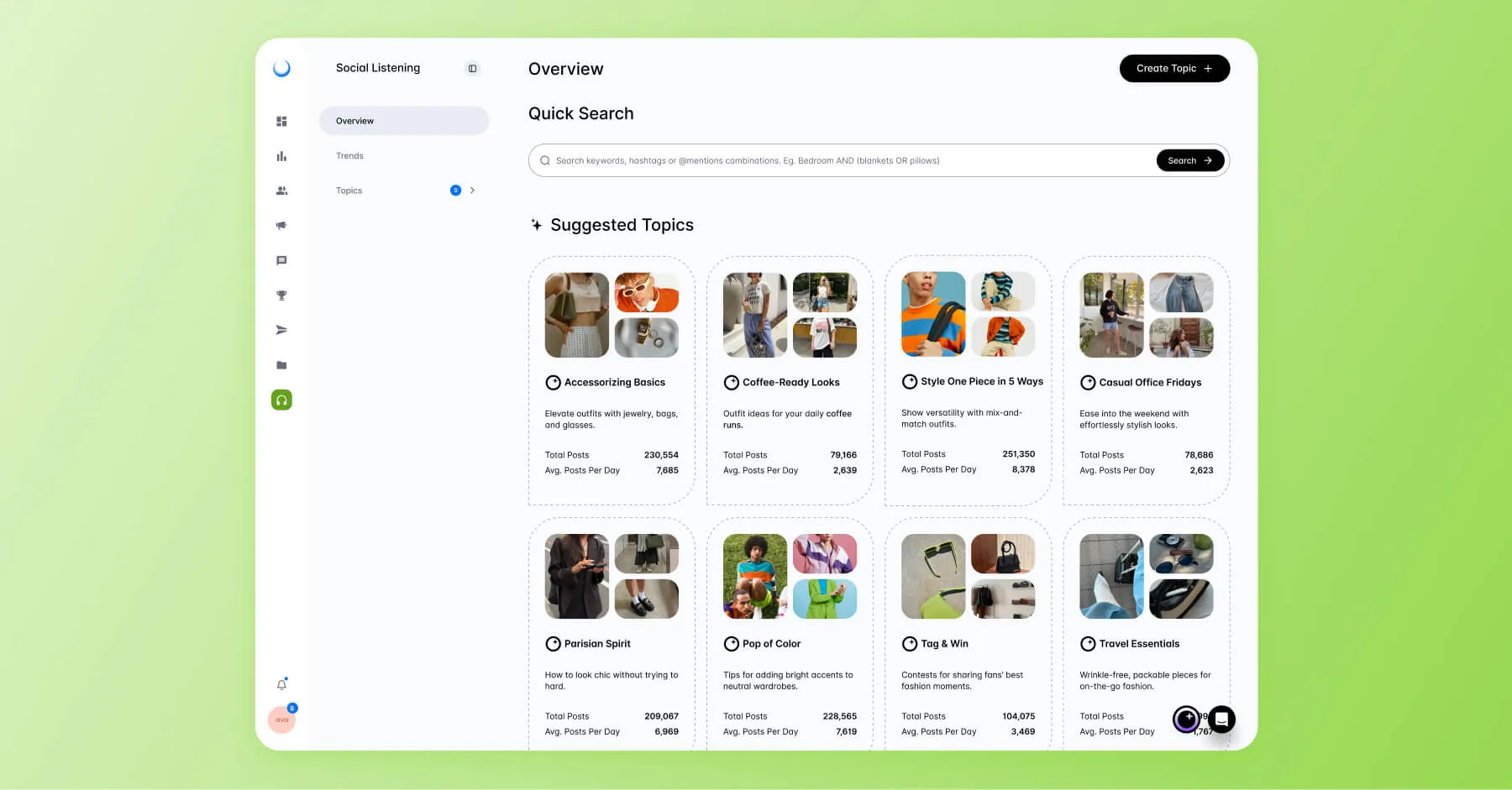
Sprout Social
Sprout Social listening offers audience sentiment analysis, trend tracking and competitive insights integrated within its management platform. It’s suitable for brands seeking a balance of engagement and listening features.
- Pricing: Starts at $249/month (listening add-on extra)
- Best for Industry: Retail, hospitality, tech
- Use Case: Social customer care + basic sentiment tracking
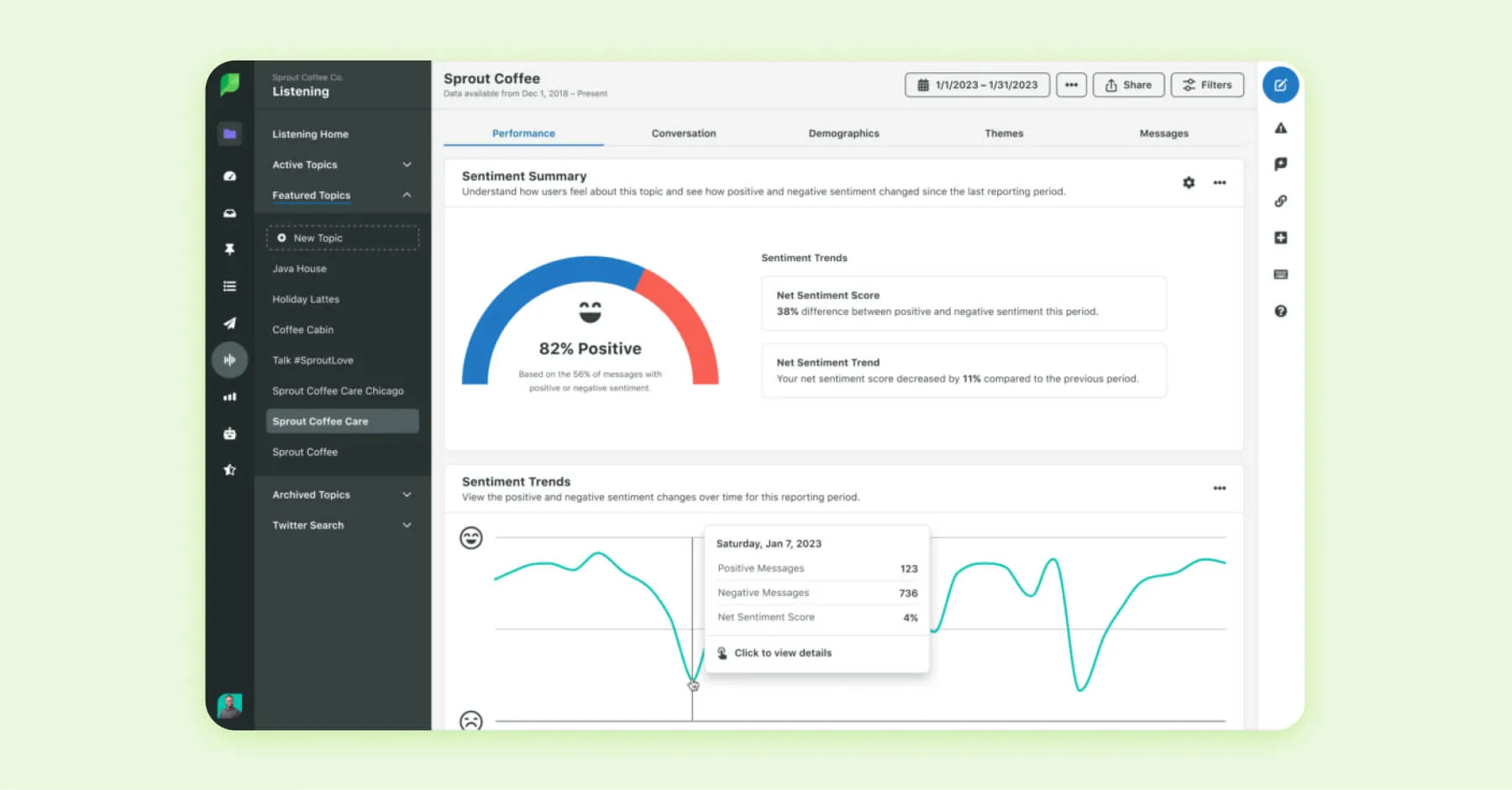
Brand24
Brand24 offers real-time monitoring of mentions across news, blogs and social media with alerts and sentiment tagging. It’s a budget-friendly option for brands that want simple tracking without the complexity of enterprise tools.
- Pricing: Starts at $199/month
- Best for Industry: Small businesses, startups
- Use Case: Brand monitoring + mention alerts
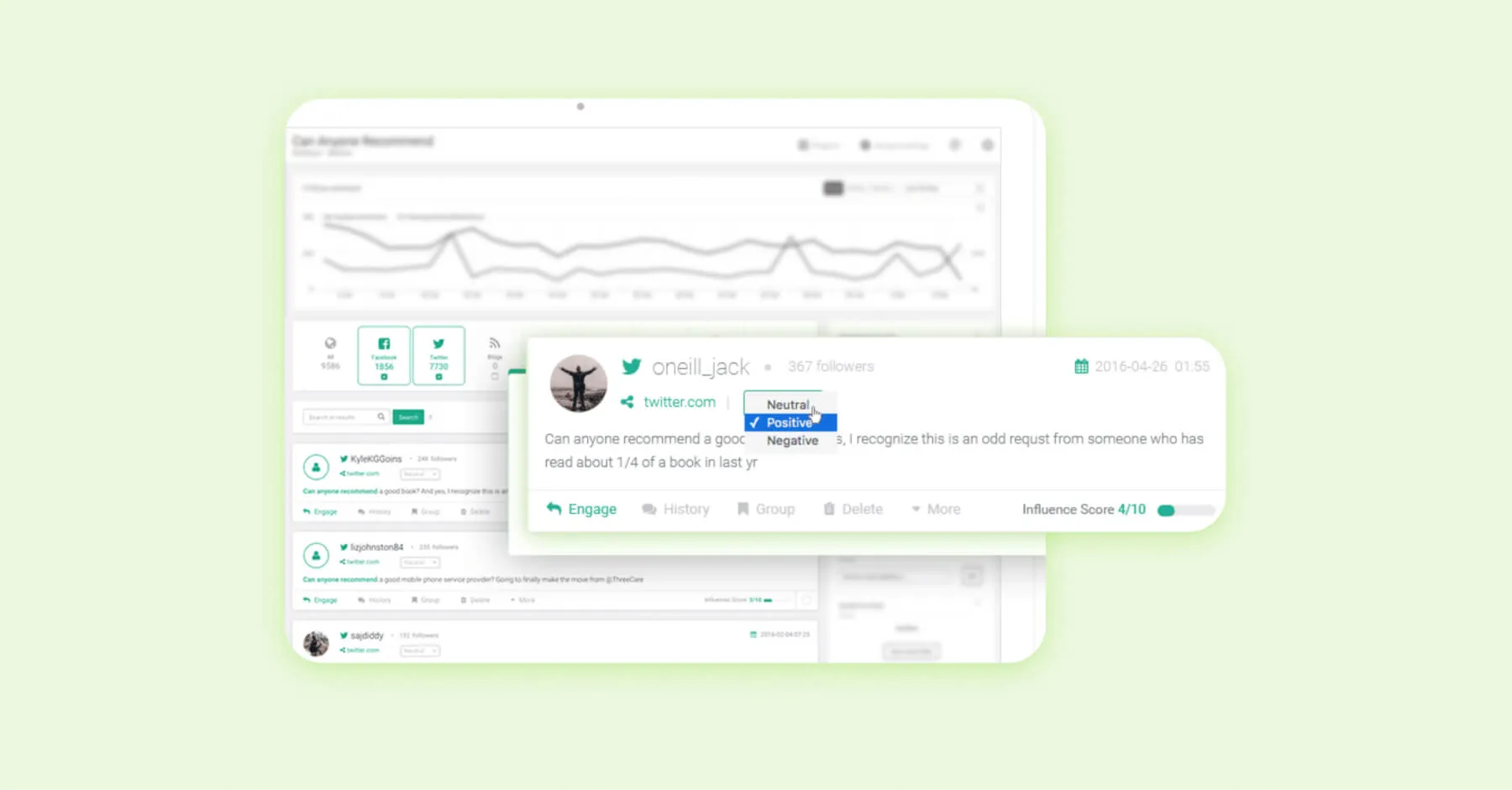
How To Start Your Social Listening Strategy
Now that you have a solid understanding of what social listening is, how it works and some tool options, the next step is putting it into action. It’s important to note that while it’s possible to manage the process manually, using a dedicated social listening tool is the most efficient and scalable way to gather insights. With or without a tool, here’s how to get started:
1. Set Goals
Setting clear goals is the foundation of any successful marketing strategy, and social listening is no exception. Start by identifying the specific insights you want to uncover. Are you tracking customer reactions to a recent product launch? Monitoring trending topics in your niche? Analyzing how your brand is perceived on a particular platform?
Defining these objectives upfront helps focus your listening efforts, streamlines the setup process and saves valuable time when it comes to analyzing and presenting your results.
2. Choose the Right Tools
With so many social listening tools on the market, finding the right fit for your brand can feel overwhelming. Start by researching top-rated platforms and narrowing your options based on how well they align with your goals. Take time to read user reviews. Most platforms offer filters by industry, company size and use case so you can get relevant, brand-specific insights into each tool’s performance.
The good news? Many platforms offer free trials, giving you the chance to test their social listening features before making a commitment. Don’t feel pressured to stick with the first tool you try. Explore a few options to see which one fits your workflow, team and reporting needs best.
3. Select Keywords, Brand Terms and Competitors
Once your objectives and channels are set, building your search queries becomes straightforward. Start by selecting relevant keywords, hashtags and phrases tied to the topics you want to explore. If you're tracking brand mentions, include your brand name and any related campaign or product hashtags. Launching a new product? Use the product name alongside your brand name to capture more specific insights.
You can also use social listening to monitor competitor activity by including their brand names and related terms. This approach provides valuable competitive insights and benchmarking data, helping you stay informed and ahead of industry trends.
4. Analyze Sentiment and Trends
Once you've gathered the data, it's time to dive into the analysis. Most social listening tools offer built-in analytics, but for deeper insight, start with sentiment analysis. This helps you understand how people feel about your brand, product or topic and if the conversation is positive, negative or neutral.
From there, look for patterns, emerging trends or unexpected outliers that could influence your strategy moving forward. Social listening is especially powerful for catching early signals so you can act before they escalate, and sentiment analysis can help you identify areas to pay particular attention to.
5. Act on Insights
Taking action is the most valuable step and ultimately the main purpose of social listening. Once you’ve thoroughly analyzed your data, your next steps should come into focus. This could be anything from stopping something that isn’t resonating or doubling down on what’s working to testing a new direction. Whatever it is, you now have the insights to make confident, data-driven decisions. These actions not only strengthen your strategy and offerings but also serve your end user in more meaningful, informed ways.
Social Listening Best Practices and Pro Tips
To get the most out of your social listening strategy, it’s not just about the tools you use but how you use them. Following these best practices will help your team stay focused, strategic and aligned across departments.
- Monitor regularly, not just occasionally. Social conversations move fast. Set a consistent cadence for checking in — daily or weekly, depending on your goals — so you don’t miss important shifts in sentiment, trending topics or potential issues.
- Loop in cross-functional teams. Social listening insights are valuable beyond marketing. Share findings with teams like customer support, PR and product to improve customer service, prepare for crises or guide product development.
- Avoid analysis paralysis. It’s easy to get overwhelmed by data. Focus on insights that directly align with your goals instead of trying to act on every comment or mention. Prioritize quality over quantity.
- Respond with purpose. Not every insight needs an immediate reply, but it should inform your next steps. Whether that’s adjusting content, refining messaging or flagging an issue internally, always act strategically, not reactively.
These best practices will keep your social listening efforts focused and effective, helping you turn raw data into real results.
Social Listening Brand Examples
The power of social listening comes to life when you see how real brands use it to shape strategy, strengthen community and stay attuned to their audience. Here’s how three brands have effectively leveraged social listening to drive success:
Summer Fridays – Strengthening Community Through Trend and Sentiment Analysis
Summer Fridays uses Dash Social’s AI-Powered Social Listening to track real-time feedback, uncover emerging trends and monitor competitor strategies. This allows the brand to make confident, data-backed decisions that keep their content relevant and their community engaged.
Result: +40% increase in engagement across channels.

Coterie – Refining Product Messaging
Baby brand Coterie leverages social listening to understand what parents are really saying about baby care products. By analyzing sentiment and common keywords, they refined their messaging to better reflect what their audience values most, leading to stronger brand resonance and improved campaign performance. You can see more about their approach in our webinar, How Children and Baby Brands Can Master Social Media Marketing.
Result:+700 increase in positive sentiment on Instagram and +470 increase in positive sentiment on TikTok.
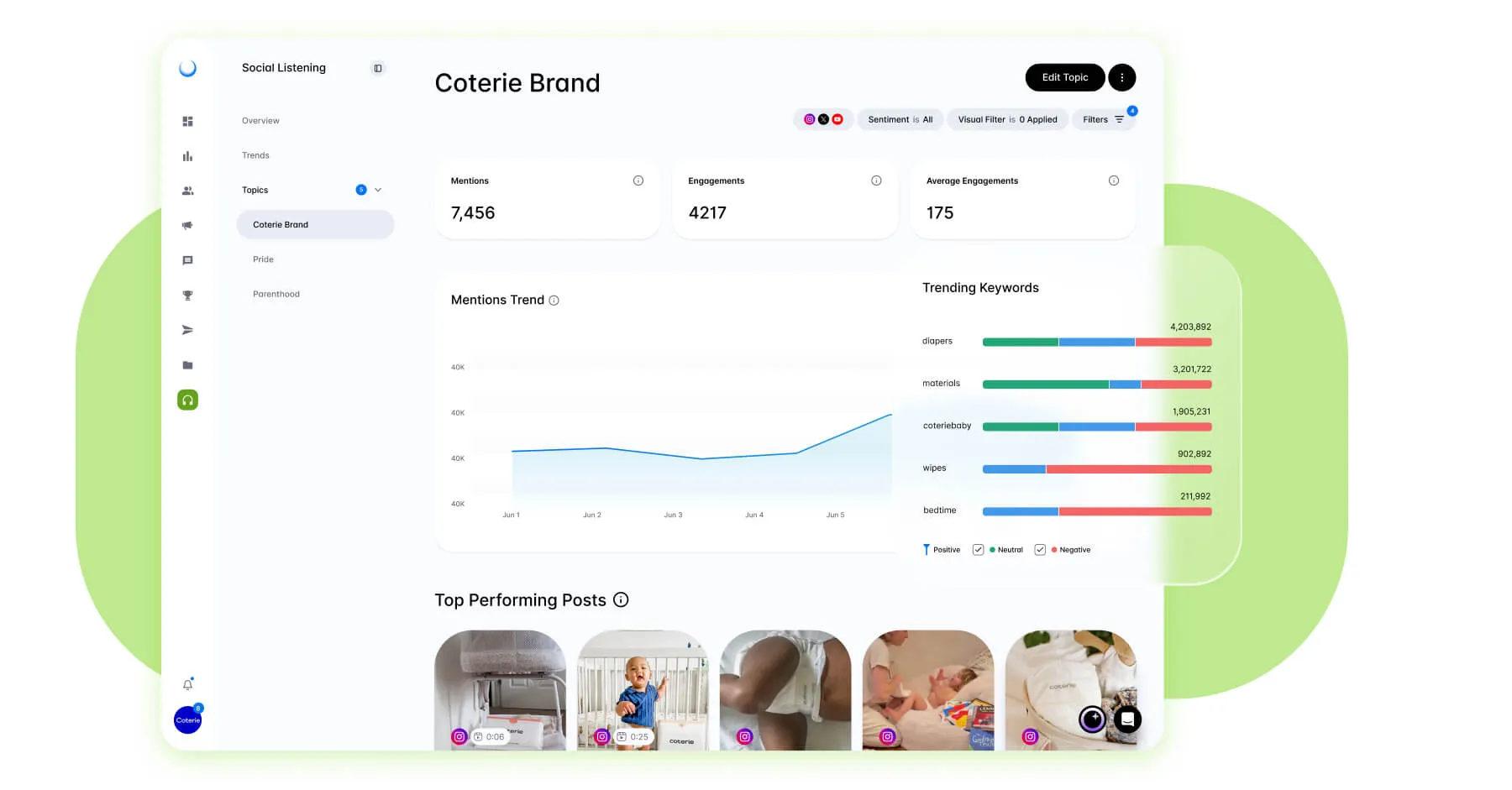
Nike – Spotting Cultural Trends Before They Peak
Nike taps into social listening to stay ahead of cultural conversations — whether it’s about athlete activism, sustainability or product innovation. By listening to what their audience and communities care about in real time, Nike is able to launch campaigns that feel relevant, authentic and impactful.
Result: Faster response time to trending topics, higher social share-of-voice

Social Listening FAQs
True or false, social listening can help you find leads.
True. Social listening can help you find leads by identifying people who are actively talking about problems your product solves, expressing interest in your industry or mentioning your competitors. By monitoring relevant keywords, hashtags and conversations, you can engage with potential customers right when they’re seeking solutions or recommendations.
Why is social listening important?
Social listening is an important part of any brand’s social media marketing strategy because it gives a real-time pulse on what’s happening in the industry with your audience and your competitors. By understanding your community on a deeper level, social listening can inform future product development, messaging and strategic planning so your brand stays relevant and responsive.
How can social media listening increase customer advocacy?
Social media listening can increase customer advocacy by helping brands identify and engage with loyal customers in real time. By acknowledging positive mentions, addressing concerns and personalizing interactions, brands can make customers feel seen and appreciated. This builds trust and encourages satisfied customers to become vocal advocates. Sharing their positive experiences and promoting your brand to others.






